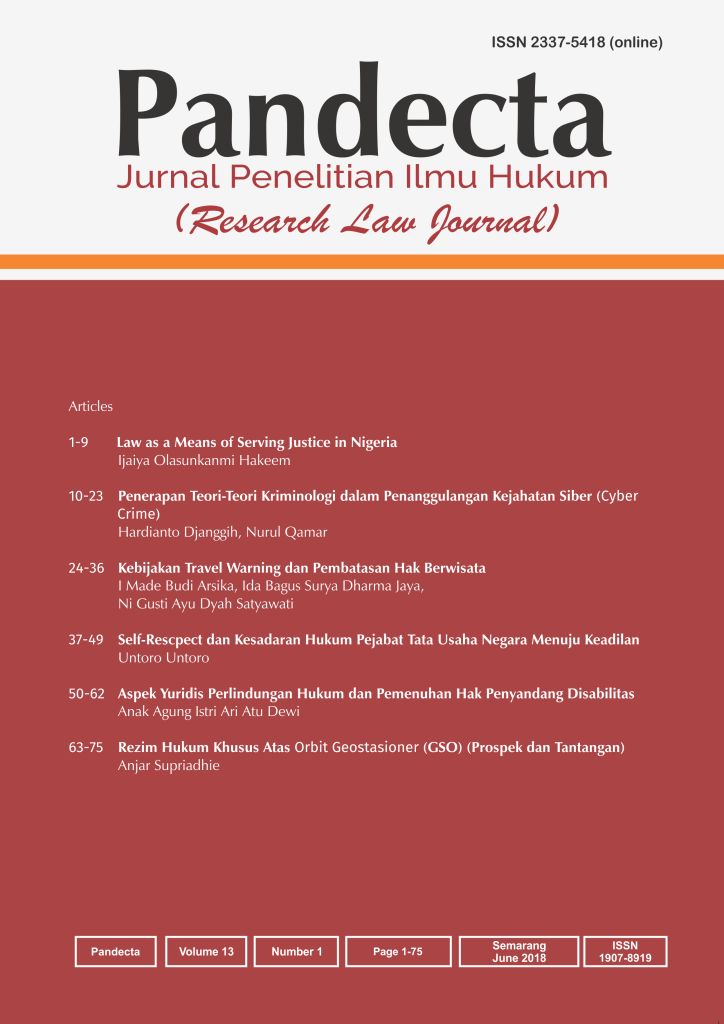Efektifitas Metode Musyawarah Mufakat Diversi terhadap Penyelesaian Perkara Anak Berkonflik dengan Hukum
(1) Faculty of Law, Universitas Negeri Semarang
(2) Faculty of Law, Universitas Negeri Semarang
Abstract
Penelitian ini bertujuan untuk menganalisis metode musyawarah mufakat sebagai implementasi diversi dalam penyelesaian kasus anak berkonflik dengan hukum. Artikel ini berargumen bahwa metode musyawarah mufakat lebih efektif digunakan sebagai metode diversi dalam menyelesaikan kasus anak pelaku kejahatan. Metode musyawarah mufakat memberikan solusi yang tepat dan biaya yang ringan serta mampu memberikan keadilan seimbang karena proses/prosedur pelaksanaannya tidak serumit model institusional hukum formal yang ditentukan dalam peraturan diversi dalam Undang-Undang Sistem Peradilan Anak. Model diversi yang diatur dalam ini lebih rigid, formal dan kurang akomodatif terhadap keinginan para pihak. Metode musyawarah mufakat lebih memberikan keadilan subtantif dibandingkan dengan model diversi secara institusional yang cenderung memberikan keadilan formal prosedural.
Â
This study aims to analyze the consensus method as a practical implementation in the use of diversion in the resolution of cases of children who are dealing with the law. This article argues that the consensus method is more effectively used as a diversion method in resolving cases of crime-harassed children. The consensus agreement method provides the right solution and low cost and is able to provide balanced justice because the process / procedure for its implementation is not as complex as the formal legal institutional model specified in the diversionary rules in the Juvenile Justice System Law. The diversion model regulated in this law is more rigid, formal and less accommodating to the wishes of the parties. In addition, the consensus method of giving more substantive justice than the institutional diversion model which tends to provide procedural formal justice.
Keywords
Full Text:
PDFReferences
Abdussalam, R dan Desasfuryanto, A. (2016). Hukum Perlindungan Anak. PTIK.
Cowell, A. J., Broner, N., & Dupont, R. (2004). The Cost-Effectiveness of Criminal Justice Diversion Programs for People with Serious Mental Illness Co-Occurring with Substance Abuse: Four Case Studies. Journal of Contemporary Criminal Justice, 20(3), 292–314. https://doi.org/10.1177/1043986204266892
Dashora, P., Erdem, G., & Slesnick, N. (2011). Better to bend than to break: Coping strategies utilized by substance-abusing homeless youth. Journal of Health Psychology, 16(1), 158–168. https://doi.org/10.1177/1359105310378385
Freiburger, T. L., & Burke, A. S. (2011). Status offenders in the juvenile court: The effects of gender, race, and ethnicity on the adjudication decision. Youth Violence and Juvenile Justice, 9(4), 352–365. https://doi.org/10.1177/1541204011399933
Hambali, A. R. (2019). Penerapan Diversi Terhadap Anak Yang Berhadapan dengan Hukum Dalam Sistem Peradilan Pidana ( Diversions for Children in Conflict with The Laws in The Criminal Justice System ). Jurnal Ilmu Hukum, 13, 15–30.
Kretschmar, J. M., Tossone, K., Butcher, F., & Marsh, B. (2018). Examining the impact of a juvenile justice diversion program for youth with behavioral health concerns on early adulthood recidivism. Children and Youth Services Review, 91(August 2017), 168–176. https://doi.org/10.1016/j.childyouth.2018.06.010
Loyd, A. B., Hotton, A. L., Walden, A. L., Kendall, A. D., Emerson, E., & Donenberg, G. R. (2019). Associations of ethnic/racial discrimination with internalizing symptoms and externalizing behaviors among juvenile justice-involved youth of color. Journal of Adolescence, 75(March), 138–150. https://doi.org/10.1016/j.adolescence.2019.07.012
Patrick, S., & Marsh, R. (2005). Juvenile Diversion: Results of a 3-Year Experimental Study. Criminal Justice Policy Review, 16(1), 59–73. https://doi.org/10.1177/0887403404266584
Patrick, S., Marsh, R., Bundy, W., Mimura, S., & Perkins, T. (2004). Control group study of juvenile diversion programs: An experiment in juvenile diversion - The comparison of three methods and a control group. Social Science Journal, 41(1), 129–135. https://doi.org/10.1016/j.soscij.2003.10.012
Rahayu, S. (2015). Diversi sebagai Alternatif Penyelesaian Perkara Tindak Pidana yang Dilakukan Anak dalam Perspektif Sistem peradilan Pidana Anak. Jurnal Ilmu Hukum, 6(1), 127–142.
Rasdi. (2009). Kebijakan Formulasi Pidana Pengawasan Dalam Hukum Pidana anak di Indonesia. Unnes Press.
Rasdi. (2016). Criminal Justice System Model to Protect Rights of Children in Coflict with Law. South East Asia Journal of Contemporary Business, Economics and Law, 9(4), 24–29.
Rasdi and Arifin, S. (2016). Model of Diversion and Its Implementation In The Criminal Justice System. International Journal of Business, Economics and Law, 11(4), 88.
Rodliyah, Jumadi, J. (2013). Implementasi Diversi Terhadap Anak Yang Berhadapan Dengan Hukum (Studi Kasus Di Pulau Lombok). Implementasi Diversi Terhadap Anak Yang Berhadapan Dengan Hukum (Studi Kasus Di Pulau Lombok), 42(2), 274–281. https://doi.org/10.14710/mmh.42.2.2013.274-281
Rodriguez, N. (2007). Restorative justice at work: Examining the impact of restorative justice resolutions on juvenile recidivism. Crime and Delinquency, 53(3), 355–379. https://doi.org/10.1177/0011128705285983
Sambas, N. (2010). Pembaharuan Sistem Pemidanaan Anak di Indonesia. Graha Ilmu.
Schwalbe, C. S., Gearing, R. E., MacKenzie, M. J., Brewer, K. B., & Ibrahim, R. (2012). A meta-analysis of experimental studies of diversion programs for juvenile offenders. Clinical Psychology Review, 32(1), 26–33. https://doi.org/10.1016/j.cpr.2011.10.002
Setyaningrum, Anita Indah, Ma’ruf, U. (2017). Diversi Sebagai Bentuk Penyelesaian Perkara Pidana Anak Melalui Pendekatan Restorative Justice oleh Penyidik Polda Jawa Tengah. Jurnal Hukum Khaira Ummah, 12(4), 975–980.
Simmons, C., Steinberg, L., Frick, P. J., & Cauffman, E. (2018). The differential influence of absent and harsh fathers on juvenile delinquency. Journal of Adolescence, 62(February 2017), 9–17. https://doi.org/10.1016/j.adolescence.2017.10.010
Sirotich, F. (2009). The criminal justice outcomes of jail diversion programs for persons with mental illness: A review of the evidence. Journal of the American Academy of Psychiatry and the Law, 37(4), 461–472.
Sutedjo, W. dan M. (2017). Hukum Pidana Anak. Refika Aditama.
Wahyudi, S. (2014). Implementasi Ide Diversi Dalam Pembaharuan System Peradilan Pidana Anak di Indonesia. Genta Publishing.
Widodo. (2015). Problematika Pembinaan Anak Pelaku Tindak Pidana Dalam Perspektif Hukum Pidana. Aswaja Pressindo.
Wilson, H. A., & Hoge, R. D. (2013). The Effect of Youth Diversion Programs on Recidivism: A Meta-Analytic Review. Criminal Justice and Behavior, 40(5), 497–518. https://doi.org/10.1177/0093854812451089
Wiyono, R. (2016). Sistem Peradilan Pidana Anak di Indonesia. Sinar Grafika.
Undang-Undang Nomor 11 Tahun 2012 Tentang Sistem Peradilan Pidana Anak.
Refbacks
- There are currently no refbacks.


